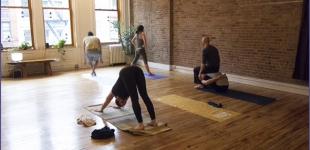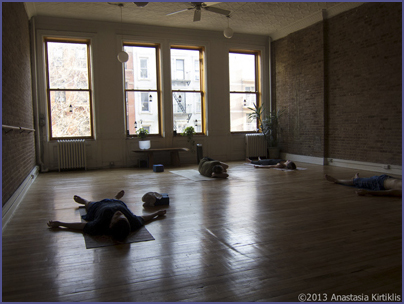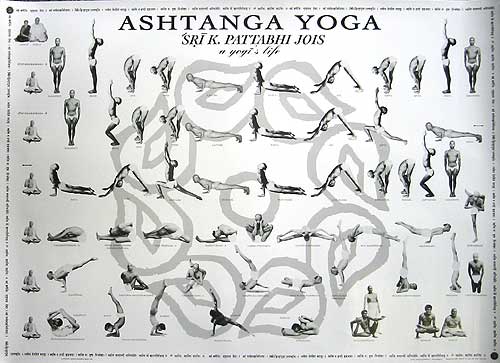tradition: ashtanga, vinyasa & 8-limbs lite™

The yoga history thread is on hold as I’ve picked up too many books on the subject to continue until they’re parsed. Much has been published since I first read up on it ten years back. If you must read something now I suggest Joseph Alter’s Yoga in Modern India. For a break, I’ll address a subject that’s come up a few times this year, that of how Hatha Yoga traditions should change.
Sometimes I explain that a way of doing an asana is a more traditional form of the pose, for example parivrtta parsvakonasana with the heel down, unbound. By “traditional” I mean over fifty years old, usually in the manner of Ashtanga or Iyengar.
There are arguments within these yoga communities about how the lineages should evolve, because as we hopefully know, most of the asanas we practice are dynamic creations of the modern era, rather than an unchanging set of postures created in the Indus Valley way back B.C.E. As Richard Rosen admonishes in his book Original Yoga, “You may have heard or read somewhere that yoga is five thousand years old, a number that’s continually cited by people who should know better, since there’s not a shred of evidence to back it up.”
Exactly.
Both Ashtanga and Iyengar are somewhat regimented practices that tend to attract intense and dedicated practitioners. While Iyengar is strict about his teachers following his method, e.g. one can’t engage in Iyengar teacher training if she doesn’t commit to teaching only Iyengar, I’ll focus this piece on Ashtanga because that’s what I practice and pay more attention to at present.
While I admit to heretic tendencies, I lean toward traditionalism when it comes to following a living lineage. One of the many things I love about ashtanga is that I know what I’m getting. I trust the wisdom of the asanas and sequences that come from Krishnamacharya, K. Pattabhi Jois, and Sharath. I can walk into a Mysore room from Rio to Seoul and know what I’ll get. We have a common language.
There are some major criticisms of ashtanga. It’s dangerous and unforgiving. It’s monotonous. It’s not for everyone. These are leveled from inside and outside the community. Several friends forwarded me a piece by Matthew Sweeney earlier this year called The Evolution of Ashtanga Yoga, which is an interesting piece, and I agree with most of it, except what we would call Ashtanga and the Ashtanga method, and who exactly should be evolving the practice. And, perhaps, on what Yoga inherently is. Sweeney argues, “Ashtanga Yoga does not suit everybody. It is not possible to teach it to everyone, despite what some teachers may say. If you consider the truth of that, therefore, it is a responsibility as a teacher to try to learn what you need to be able to teach anyone. Otherwise it is not Yoga, and too limited.”
I find the idea that any kind of yoga (much less Ashtanga) should be suited to everyone ridiculous, as well as the argument that a teacher should aim to teach every population at large. Otherwise it is not Yoga? By what definition? Hatha Yoga was developed by a fringe ascetic population, and definitely not available to or desired by everyone, and the Yoga of Patanjali’s Sutras was aimed at and permitted for the Brahmin (highest) class alone.
 If you’re bored of teaching Ashtanga sequences and want to shake up the method and the type of [aggro!] students you attract, do it. But when you’re adding moon salutes and yin yoga into the same practice, it’s no longer Ashtanga. It may be incredibly valuable, but it’s now vinaysa, or moon unit yoga, or even Reform Ashtanga. But it’s not Ashtanga. That on some level Sweeney agrees is obvious here: “For me it is simply a matter of timing, of when it is appropriate to introduce either the tradition – the Intermediate Series, for example, or an alternative such as Vinyasa Krama, or Yin Yoga or meditation.” Exactly. Vinyasa Krama and Yin Yoga are not the Ashtanga tradition, but traditions of their own.
If you’re bored of teaching Ashtanga sequences and want to shake up the method and the type of [aggro!] students you attract, do it. But when you’re adding moon salutes and yin yoga into the same practice, it’s no longer Ashtanga. It may be incredibly valuable, but it’s now vinaysa, or moon unit yoga, or even Reform Ashtanga. But it’s not Ashtanga. That on some level Sweeney agrees is obvious here: “For me it is simply a matter of timing, of when it is appropriate to introduce either the tradition – the Intermediate Series, for example, or an alternative such as Vinyasa Krama, or Yin Yoga or meditation.” Exactly. Vinyasa Krama and Yin Yoga are not the Ashtanga tradition, but traditions of their own.
Sweeney also argues:
In terms of human evolution and holistic development, sooner or later any technique or tradition you might adhere to becomes limiting, and a lessening of your full potential. For you to embrace a true spiritual perspective, you will need to move beyond a single method or one dimensional view.
Let’s break this down. First, to argue that Ashtanga (or Iyengar, or Yin Yoga, or Zen, or whatever) is “a one dimensional view” because it is a single method, is simplistic and incorrect. Further, to create a patchwork of practices sooner rather than later is tantamount to disaster, because as soon as things become a little bit difficult, uncomfortable, or boring, you will continue to seek distraction elsewhere, most likely at the moment you were starting to get somewhere. This is why most mature spiritual teachers and traditions advise making a commitment to one practice. For a long time. This is not to say that we as practitioners discount other practices or perspectives, but we know temptation when we see it. That said, when a certain level of mastery has been attained, after years and years of practice, it’s very helpful to see what other traditions can offer your own.
Sweeney finds it:
…curious that I am one of the few traditional Ashtanga teachers to actively embrace different sequences and encourage many students to practice them – without abandoning the standard Ashtanga. Alternative sequences can enhance the Ashtanga method without altering or threatening its form and function. Why are the Ashtanga sequences treated as a sacred cow? It is a wonderful practice, but just Asana sequences at the end of the day.
As I understand it, the holders of the lineage, first P. Jois and now Sharath, have explicitly asked teachers not to change up the sequences. So, it’s not so curious as to why most teachers don’t. While I don’t hold the sequences sacred, I’ve taken enough bad vinyasa classes to know the genius of good asana sequences. I question the suggestion we all change them up at whim. At the end of the day, a good asana sequence is a rare thing, and the Ashtanga series are integral to the Ashtanga method. Altering them is a threat because if “It is up to each of us to work out what the advantages and disadvantages are,” then before you know it, anyone teaching anything can and will call themselves Ashtanga. And where does that leave us? With another vinyasa practice, now called Ashtanga, whatever that means to each of those who’ve redefined it.
And that, I suppose, is my real issue. Again, Sweeney:
I use alternative sequencing to aid and enhance the Ashtanga practice rather than to replace it entirely. It is all about what is appropriate and practical, rather than blind faith, dogma, or just doing random stuff because I feel like it – though honestly, sometimes the latter can be really useful.
So, we’re back to the alternatives being alternatives to Ashtanga rather than being Ashtanga, and I’m fine with this. While Sweeney likely has the wisdom and experience to change things up for the better of his students, some 23 year old who just finished a weekend workshop in Ashtanga may well not. But he’s certified! Do I really want to walk into his class and learn his new variations on secondary series? Do I want him teaching others this brave, new Ashtanga? No. Beyond no.
 This is why Ashtanga is a lineage trad and vinyasa is not. Yes, the method should change, but that change comes from the holder of the tradition, which is at present, Sharath.
This is why Ashtanga is a lineage trad and vinyasa is not. Yes, the method should change, but that change comes from the holder of the tradition, which is at present, Sharath.
If we want to change up the series, perhaps we should call what we’re doing Reform Ashtanga. If we want to make it “accessible” to those who, in reality, don’t want to make the commitment that the Ashtanga method requires, perhaps we should call it YogaWithBenefits. If we want to break down the sequences and asanas so they can be taught by teachers who have never had a Mysore practice and students who don’t even know what that is (they’re out there, and certified as Ashtanga teachers by YA to boot), perhaps we should call it 8-Limbs Lite™. There is probably a lot of value in all of this. But it is not Ashtanga-Vinyasa Yoga. I have no problem with changing things up, I just want to know what I’m getting. And that’s really the biggest problem with vinyasa yoga now. You really have no idea.
The Ashtanga method is impressive in part because of just what is accessible to someone who makes the commitment to Mysore six days a week. I once thought that Ashtanga was not for everyone, and I still do. I don’t believe that anything, aside from clean air and water, is for everyone. But I believe it’s available to far more practitioners than I did before I practiced it. And that is part of the beauty of Mysore Ashtanga. When it is watered down, it is lost.
It’s difficult to make this rigorous commitment, and it might not be possible for most householders. Maybe we do need a more accessible, codified Reform Ashtanga or 8-limbs lite™. But, please, call it what it is.
I wish Sweeney had been a little more clear on whether he thinks that Ashtanga + yin sequencing (etc) is still Ashtanga—in some places it seems yes, in others no. I also wish that he’d put his last paragraph first, as maybe we agreed all along:
It is not a question of right and wrong, it is a question of whether you can admit that wherever you sit on the spectrum, can you embrace both ends of it? Are you closer to the traditional centre, but do you deny the importance of those who change, explore and adapt? Or are you closer to the edge, finding new ways and expanding your horizons, but you find it hard to accept the strength and clarity of those closer to the centre? Embrace all of it and you embrace your full potential.
Other than the last line coming off like a weird platitude, and that I’m confused by the spectrum-both-ends-centre-edge-dichotomy metaphor, I agree. I practice Ashtanga in the morning and meditation, yin and restorative later in the day. I teach vinyasa, which is a little bit of everything I practice. I quite like it that way. It is important to be clear about what things are, and what we, as teachers, offer. It’s also important to respect the wishes of lineage holders as best we can, even if that means leaving the lineage. It is lovely to have lineage traditions, even if only as a point of reference. It’s equally important to have adapters and pioneers. But if we aren’t clear about which is which, in today’s yogamarket, it becomes impossible to discern.
Hi.
Thanks for your sincere post. I’ve translated Sweeney’s article into Russian, but didn’t share it because of it’s arguable content.
Now it’s possible with your post.
Thank you.
Dmitry Baryshnikov
Moscow, Russia
Дмитры, не за что!
Very glad it’s useful. ~Anastasia